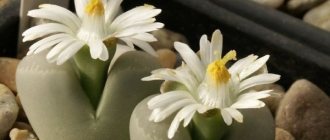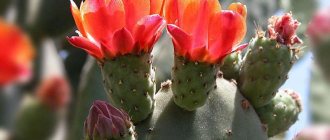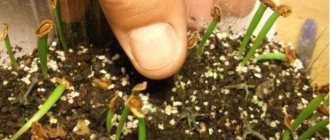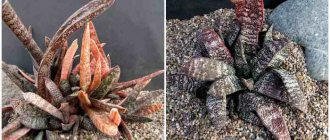Photo of nephrolepis in a pot Nephrolepis (Nephrolepis) is an ancient, herbaceous, perennial plant of the fern genus, widely cultivated in indoor floriculture since the first half of the 19th century, as an ornamental foliage crop. Nephrolepis is native to the humid South Asian tropics and subtropics. It grows actively throughout the year and can double the volume of green mass in a year, with virtually no dormant period.
It has a well-developed root system, over which a powerful rosette of complex, pinnate, short-petiolate leaves up to 70 cm long is formed. Different types of nephrolepis fern have different degrees and shapes of segmentation of leaf blade segments and a height from 50 cm to one meter or more.
| Growing quickly. In one year it can increase 2-3 times. |
| Nephrolepis does not bloom. |
| The plant is easy to grow |
| Perennial |
Meet Nephrolepis
Nephrolepis is a herbaceous plant that is an epiphyte or grows on the ground. It has an underdeveloped stem that produces short shoots.
Lush greenery of fern will decorate any interior
The homeland of this lush splendor is regions with a tropical climate. In the wild it can be found in Africa, Asia, America, Australia, even Japan and New Zealand. Under natural conditions, the fern grows very quickly.
Its long feathery leaves, called fronds, are collected in a rosette. The fronds can reach 70–80 cm in length.
Contrary to the legends about fern flowers, the plant is non-flowering and reproduces by spores, dividing the bush or layering. The spores are collected in groups, forming so-called sporangia. They look like miniature, initially green, convex dots, and as they mature, they become brownish fluffy lumps. They are located on the underside of the leaves.
Many spores mature in fern sporangia. which will subsequently give rise to new colonies of the plant
Several types of nephrolepis are bred at home. Among them there are unpretentious ones that do not cause much trouble, and there are also capricious picky ones with whom you will have to tinker. Which option is preferable is up to each owner to choose for himself, but in any case, the efforts will be rewarded. A healthy plant unusually enlivens the interior with a cap of lush leaves.
The green mass of fern not only produces oxygen, but also has antimicrobial activity. Nephrolepis absorbs formaldehyde, xylene, and toluene from the air generously released by household items.
Indoor types of nephrolepis
There are several varieties of nephrolepis that gardeners grow as indoor plants:
- Nephrolepis sublime;
- nephrolepis Boston;
- nephrolepis cordifolia;
- nephrolepis xiphoid;
- nephrolepis Green Lady;
- Emin's nephrolepis;
- blechnum, which belongs to the Derbyankov family.
Nephrolepis exaltata
One of the most commonly found ferns in home cultivation. The plant is unpretentious, caring for it will not be difficult. Its long (up to 50–70 cm) green fronds are collected in a lush rosette. Aged leaves turn yellow and dry out before falling off.
Nephrolepis sublime is one of the most common varieties of fern.
This variety can reproduce both by dividing the bush and by spores. Nephrolepis sublime gave rise to the breeding of a mass of hybrids.
Nephrolepis exaltata var Bostoniensis
A variety bred, as the name suggests, in Boston from Nephrolepis sublime. It is distinguished from its progenitor by wavy, twisted leaves. The fronds of this species can reach 1.2 m in length. He gave rise to the breeding of varieties with leaves of complex shape, consisting of two, three and four leaves fused together. This variety is most resistant to dry air.
Boston nephrolepis is distinguished by its original wavy leaves
Nephrolepis cordifolia
This representative of the family owes its name to the original shape of the leaves on long, almost vertically growing fronds.
When you see the leaves of this variety, the origin of its name becomes clear.
Tuberous formations can be seen on the root system of this species. Sori are attached along the underside of the heart-shaped leaves. This species, like the previous one, reproduces by spores and division of the bush.
Nephrolepis bisserata
The leaves on the fronds of this species have the shape of pointed swords. Spores are attached to the green leaves on the underside. This plant does not form tubers. A distinctive feature of Nephrolepis xiphoidum is its lush crown, reaching 1.5-2 m. Fronds of this size make this variety inconvenient for cultivation at home in an ordinary apartment. You can meet this giant in greenhouses and winter gardens.
The pointed sword-shaped shape of the leaves clearly distinguishes this variety from other ferns.
Nephrolepis Green Lady
A variety of fern characterized by a spherical “fountain” of green, pointed leaves. The fronds are densely covered with lacy lobes growing close to each other. The plant is demanding on air humidity.
Strong, lush fronds of Green Lady are big fans of humidified air
Nephrolepis Emina
A low-growing compact plant whose fronds are elastic and almost vertical. Its second name is Dragon Tail (dragon tail) or Green Dragon (green dragon). Its unusual “curly” leaves make it especially attractive. This species grows up to 50 cm
Nephrolepis Emin strikes with elastic fronds covered with curly leaves
Blechnum is another representative of ferns popular among gardeners, although from a different family - the Derbyankovyh. In natural conditions, its fronds reach a length of up to 1.5 m. It has earned recognition among indoor plant lovers thanks to its fronds covered with green palm-shaped leaves. With age, the rhizome grows above the ground and changes, becoming like a trunk. The plant as a whole resembles a palm tree. This type of fern is capricious and demanding in terms of growing and care conditions, but for the sake of such beauty it is worth trying. At home, with proper care, fronds can reach a length of up to 1 m.
The lignified modified rhizome and fronds with long leaves give the blechnum a resemblance to a palm tree
Beneficial properties of nephrolepis
Nephrolepis fern is valued for its beautiful appearance and beneficial effect on the microclimate of residential and industrial premises:
- absorbs formaldehyde and toluene, which emit polymer materials in finishing;
- has a detrimental effect on microbes, has phytoncidal and antibacterial properties;
- increases human immunity and performance, normalizes psychological state and blood pressure levels;
- reduces noise levels;
- increases air humidity.
People believe that nephrolepis has enormous power, capable of bringing into harmony the energy of the external world and the internal state of a person, extinguishing negative energy. It awakens the hidden forces of the body, stimulates the disclosure of abilities, and improves family relationships.
Conditions for keeping nephrolepis at home
Keeping nephrolepis at home requires compliance with certain parameters, as well as rules of care depending on the time of year.
Table: requirements for keeping nephrolepis at home
| Season | Lighting | Humidity | Watering | Temperature | Top dressing |
| Summer | Diffuse, bright light, preferably located on windows facing west or east. Direct sunlight is contraindicated. Possible placement on a balcony, loggia, terrace in partial shade | Humidity - at least 60%. Requires daily spraying with warm soft water. It will help to place a pot of flowers on a tray filled with moss and expanded clay soaked in water. The container with the flower should not be immersed in water | Watering is sufficient, you need to focus on drying the top layer of the substrate | +20о…+24оС | Fertilizers produced for ornamental plants are used weekly in diluted form (1/4 or 1/2 of the recommended amount) |
| Winter | In winter, additional artificial lighting may be required for at least 6–7 hours | Humidity - at least 60%. Requires daily spraying with warm soft water. It will help to place a pot of flowers on a tray filled with moss and expanded clay soaked in water. The container with the flower should not be immersed in water | Water carefully, 2-3 days after the top layer dries. | +16о…+18оС | Extremely rare, it is better to completely stop feeding - excessive efforts at this time are fraught with disastrous consequences for the plant |
Fern Nephrolepis in the expositions of the florarium
A florarium is an original composition of flowers with the addition of various decorative elements, placed in a transparent vessel made of glass or plastic.
A number of varieties of nephrolepis, due to their compact size, are used in the preparation of compositions for florariums. The variety Bostoniensis Compacta, bred from Boston nephrolepis, has a very small size (up to 40 cm). This feature allows it to be used for growing in florariums. This species is quite unpretentious; in a florarium, subject to high levels of humidity and temperature conditions, it will delight the owner with juicy greens. To compose florarium compositions, you can also pay attention to varieties such as Dallas Jewel, Teddy Junior. They are small in size, organically fitting into florarium ensembles.
Croton is also perfect for a florarium, read about it:
Photo gallery: florariums using ferns
Small size allows the plant to be used in florariums
Florarium is a composition of flowers and various decorative elements
Small ferns fit original into frolarium ensembles
Characteristics and species diversity of nephrolepis
The fern has a well-developed root system. The roots are shortened and superficial. The leaves are collected in a basal rosette. They are attached to the bush using shortened petioles. The shape of the plates is lanceolate, segmented. The edges of the segments can be smooth or serrated, depending on the type.
The length of the leaf reaches 70 cm, the length of the segment is up to 5 cm. The color of the leaves is bright green, mainly in light green shades. In the Variegate variety of nephrolepis, the color of the plates combines light green and yellow.
In addition to the leaves, bare scaly shoots extend from the rhizome. They are used for vegetative propagation of ferns.
Green Lady
The variety got its name for its tenderness and femininity. Representatives of Green Lady are often called a green fountain or fireworks. Refined fronds cascade down like streams. The leaves grow very densely, creating a lush bush.
Green Lady
They are bright green, slightly curled, with pointed tips. The segments are openwork. Flowers are grown as hanging plants. Due to their unpretentiousness to lighting conditions, they can be placed in any part of the room.
Exalted
This variety is considered the most common nephrolepis. Moreover, it is the progenitor of the bulk of indoor fern hybrids.
The leaves of sublime nephrolepis are very long, erect, and can rise above the bush or hang from it under their weight in lush arches. The fronds are single-pinnate, but contain about fifty segments. The color of the leaf blades is light green.
Exalted
This variety is considered the most unpretentious, since it is the most resistant to adverse environmental conditions.
Curly
Nephrolepis Curly, or Curly, is a hybrid of the Exalted variety. The fern got its name from the combination of twisted segments and wavy edges on one plate, which create a curly effect. The plant is grown as an ampel plant.
Curly
The leaves are lush green, drooping. The curly hybrid has one more characteristic difference - it is low-growing, so it easily fits even on a cramped shelf.
Sonata
Nephrolepis Sonata is a dwarf fern with small leaves. Representatives of this variety bush in a spherical shape, so they are often grown on window sills or small cabinets. The leaves have a bright light green color.
Sonata
This variety of nephrolepis is undemanding in terms of lighting. It grows well even in the shade.
brindle
The tiger variety can also be found under the name Nephrolepis Variegate. This is a compact fern designed for growing in floor pots.
brindle
Representatives of the Tiger variety are distinguished by erect fronds that reach half a meter. The plates are segmented and covered with a marble pattern that combines yellow and light green tones. The pattern resembles the striped color of a tiger.
Nuances of care
It is not difficult to care for this green miracle. It must be remembered that the plant is a native of the tropics. Hence the increased sensitivity to dry air and watering.
Lighting
Nephrolepis is a lover of light; it should be placed in places with sufficient illumination, trying to avoid the sun's rays hitting the plant directly. Windows facing east or west are suitable. Nephrolepis does well under artificial light: it can often be found in various offices and institutions, where the fern gets enough light from lamps running for a long time.
In summer, the green pet can be taken out into the open air, not forgetting to provide shade from the sun to avoid burns.
In winter there is little light in the rooms, so additional lighting will be useful.
Humidity
A native of the humid tropics, Nephrolepis requires humidified air. Daily spraying with soft (necessarily warm) water will help, and in the summer it must be done in double volume.
You can place the plant on a moistened tray filled to the top with some kind of filler (expanded clay, moss). It’s just important not to “drown” the bottom of the pot: it should stand as if on a stand. These requirements must be observed regardless of the season.
Nephrolepis will respond gratefully to shower procedures. Warm water will not only keep the leaves moisturized, but will also wash away accumulated dust.
Humidified air is suitable for growing mimosa pudica. Read more about this exotic plant:
Top dressing
Nephrolepis needs to be fed depending on the season. In summer - 1 time every 7 days. For feeding, you can use fertilizers recommended for ornamental plants, diluted by half or 3/4 with water.
In winter, fertilizers are used to a minimum, and it is better not to feed at all, since applying an excessive amount of fertilizer during this period can lead to plant disease.
Some mistakes in caring for it can have an adverse effect on the health of the plant.
Table: errors in organizing care for nephrolepis
| Symptoms | Possible errors | |||
| Watering | Temperature | Humidity | Top dressing | |
| Leaves turn yellow and dry | Excess water - the lower leaves turn yellow, their tips turn brown and dry out. Lack of water - the growth of leaves stops, their lethargy and yellowing are observed. Cold water. Hard water | The leaves turn yellow from the base - unfavorable temperature, should be moved to a cool place. When the temperature rises (>25°C), increase the frequency of spraying. When the temperature drops (<12°C) - reduce the volume and number of waterings | Spraying in direct sunlight | — |
| Young fronds wither and die | Use for cold water irrigation | Reduced temperature | Low humidity, the number of sprays should be increased | — |
| The plant fades and stops growing | — | — | — | Not enough nutrients, add fertilizer |
| Leaves turn yellow over time | Natural process, dried fronds should be removed | |||
Botanical description
Nephrolepis flower is a herbaceous plant, epiphytic or terrestrial, with a short rhizome, a rosette of light green, short-petioled pinnately compound leaves up to 70 cm long, consisting of lanceolate, serrate-crenate along the edge of segments up to 5 cm long, on the lower side of which on both sides the midrib contains round sori. With age, the leaves turn yellow and fall off. Leafless shoots, covered with scales and easily rooting, extend from the rhizome.
Table: diseases and pests of nephrolepis
| Diseases and pests | Symptoms | Ways to fight | Prevention measures |
| Gray rot | Gray fluffy coating on leaves, cuttings | Treat with fungicide (Trichophyte, Alirin-B) | Avoid stagnation of water, water with cold water at low temperatures |
| Spider mite | White dots appear on the leaves, the leaves gradually dry out, with severe damage a thin web is visible | Wash with warm water and laundry soap, in case of severe damage, treat with special products (Aktellik, Aktara, Condifor) | Regularly ventilate the room, spray the plant, periodically wash it in the shower |
| Whitefly | Yellowish spots appear on damaged leaves. the leaves dry out | Wipe the leaves with a water-alcohol solution (1:1). Treat with insecticides (Fitoverm, Aktellik, Aktara, Condifor) | Observe the temperature and water conditions, avoid high temperatures and high humidity - ventilate the room more often, regularly wash the flower in the shower |
| Mealybug | A white coating appears on the leaves, they look damaged and turn yellow. Pests are visually visible | Wash the fern with soapy water, and after drying, treat with insecticides (Fitoverm, Aktellik, Aktara, Inta-Vir) | Regularly inspect the plant, ventilate the room, spray, wash |
Nephrolepis diseases
Horse rot . It can appear due to excessive watering. The first signs are yellowing leaves for no apparent reason.
In the initial stages of the disease, the plant can be saved - you need to remove it from the pot, remove the affected parts of the roots and leaves, replant it in a new pot with fresh soil and treat it with Fundazol (3).
Gray rot. It also appears with excess moisture, especially in combination with coolness, or with excess nitrogen fertilizers. Looks like mold.
The first step is to remove all affected parts of the plant. Then treat the fern with Alirin-B or Planriz (3).
Anthracnose. Another fungal disease caused by excess moisture. Its signs are dark spots on leaf segments and brown “smudges”.
For treatment, you can use the drug Fitosporin-M (3) - you need to carry out 2 treatments with an interval of 10 days.
Reproduction of nephrolepis
Nephrolepis can be propagated in several ways:
- disputes;
- dividing the bush;
- shoots;
- tubers.
Reproduction by spores
This method is difficult due to the likely sterility of spores from domestic crops or the presence of incomplete hereditary information about the parent. If you really want to, you need to do the following:
- Carefully separate the ripened grains with a knife, placing them on paper.
- Place the spores on the prepared soil. Drainage is required. For the greenhouse you need to use a plastic container with a lid.
- Place the seeds on a moistened substrate, cover with a lid and leave in a warm, shaded place.
- The incubator should be ventilated and the soil moistened periodically. Under favorable circumstances, it will take about three months for the seeds to germinate. When the sprouts grow and become stronger, they need not be covered.
- The shoots that have formed a rosette can be planted.
Spores of domestic nephrolepis cultures can be sterile, so this method of propagation is difficult and rarely used
Reproduction by dividing the bush
This is the simplest and most common option:
- During spring transplantation, the rhizome is divided into several parts. It is necessary that each new bush has a growth point.
- Small bushes are planted separately.
Reproduction of nephrolepis by dividing the bush during transplantation is the simplest and most common option.
Reproduction by shoots
The “whiskers” hanging seemingly idle will help you get a new fern:
- Leafless shoots should be taken to the side, pressed to the substrate and placed in a separate container.
- They need to be buried so that the middle is covered with soil by about 1 cm.
- We must not forget about constant hydration.
- After two weeks, roots will appear, and then small shoots. When the young shoots become stronger, they can be separated from the mother plant and planted separately.
For this method of propagation, leafless shoots of nephrolepis are taken to the side and pressed to the ground in a separate container until they take root.
Propagation by tubers
Some species form moisture-saving tubers on their roots. They can be clearly seen when transshipping the plant. This propagation method is incredibly simple:
- The tuber is separated from the roots.
- Then it must be placed in the prepared substrate.
- The soil is moistened as usual.
Tubers form on the roots of many types of nephrolepis, which are excellent for plant propagation
Optimal conditions for reproduction
Edible bracken fern - what it looks like and where it grows
Nephrolepis reproduces in several ways. The simplest option is to root leafless offspring. One of the lashes is placed in a pot of soil, which is placed next to the fern. The whip is not separated from the mother specimen. The offspring is simply dropped in a new pot. After a few weeks, rooting occurs. After this, the whip is cut off from the adult nephrolepis.
Another simple way is to divide the rhizome. Then parts with growth points are taken from an adult bush. The separated seedling is buried in the prepared soil.
Fern propagation by dividing roots
Creating good conditions for reproduction means providing sufficient humidity and warmth. The light should be diffused, but there should be plenty of it.
Nephrolepis fern is suitable for any interior. There are many different types of herbaceous plants that differ in appearance. Nephrolepis grows quickly and perfectly purifies the air. This spectacular perennial requires little care and is suitable for beginner gardeners. The main thing is to water it on time.
Reviews about the plant
This is one of the most unpretentious ferns, a very spectacular plant.
I dearly love this unpretentious indoor fern. In September, I planted a huge basin-like pot, and everyone was gifted with ferns. But it didn’t start growing well for me right away. First, I managed to get a plant with three half leaves, around which I danced with a tambourine, I really wanted a big beautiful fern. But my dancing didn’t bother him one bit, and he kept standing there, apparently wondering whether life was worth living. And so, while digging through the Internet in search of an answer to what he needs, I came across a recipe that I want to share. To replant, you need to dilute the soil very generously with pine bark. We also add pieces of coal, pine litter, and you can add sphagnum moss. It wouldn’t hurt to mix in some sand if the land is purchased, otherwise there is usually only peat. And it’s better to take a flat pot, not a tall one. Transplanted in this way, my little one somehow quickly recovered and began to grow, and now there are no problems with it. But it does not like drying out, and it is better to monitor the soil moisture. After all, it stands high, and the fact that it is dry is not immediately noticeable. The fronds do not wither, but just somehow turn pale and begin to dry out at the tips of the leaves. But the saddest thing is that the “snails” dry up without having time to turn around. A beautiful house plant, unpretentious and grateful for care, I recommend it! irkin44 https://irecommend.ru/content/zelenyi-vodopadik-sekret-uspeshnoi-posadki
I have the same.
It needs to be moved to the window, otherwise the leaves are long and sparse. But when it fluffs up - oh, and handsome! All the guests are looking in. Elf https://otzovik.com/review_217759.html
I've had ferns for a long time, about 15 years to be exact.
I'm always surprised when you complain about the lack of light for them. In my experience, they are only beautiful and green in winter. When spring comes and the sun comes, they begin to turn pale. If I take them out into the yard and onto the completely shady side, where the sun never hits them, it’s the same thing. They become pale. Here are mine on the veranda in winter, now I have already taken them off and hid them in the northern rooms. Jike https://forum.bestflowers.ru/t/nefrolepis-nephrolepis.146911/page-51
I love this plant for its luxurious thick greenery, for the interesting observation of how a beautiful carved frond appears from the “snails”, and so on ad infinitum!
My little children kept coming up and waiting for little green, furry balls to appear on the surface of the earth, changing in size every day. The plant survives quite well. But if you want it to be a rich green color, it needs to be provided with favorable conditions. The main thing is not to overwater, often spray with settled water, do not feed with fertilizers, it is enough to fertilize twice with liquid fertilizer for ornamental flowering plants. In very bright light, nephrolepis fronds turn pale, so it should not be placed on a southern window. But it also fades in the shadows. The most successful window will be the eastern one. On New Year's Day we decorate it with rain, it looks very original. A very good fern with lush forms. Clarice https://irecommend.ru/content/ochen-khoroshii-paporotnik-s-pyshnymi-formami-foto
I love ferns; I have several of them at my summer cottage.
Maybe that’s why I love nephrolepis, because it is also a representative of ferns. Amazingly beautiful at home. It is not difficult to grow, it grows very quickly and is unpretentious. It prefers moist soil, likes spraying, grows well in partial shade, fertilizing is needed from time to time. Anna Zakharchuk https://flap.rf/Animals_and_plants/Nephrolepis/Reviews/6437440
Methods for propagating indoor plants
Nephrolepis reproduces in three ways: by shoots, by dividing the bush and by spores. In indoor floriculture, only the first two methods are popular.
Usami
Whiskers are special shoots that the plant sends out directly from the leaf rosette. Outwardly, they appear as bare shoots.
Fern propagation by whiskers involves the following steps:
- An additional pot filled with moist fern substrate is placed next to the mother plant.
- The mustache is dug into the soil of an additional pot so that its base remains on the mother bush, and the top is in the air.
- For reliability, the mustache is fixed with a bracket or pin.
Rooting the shoot
The soil of the additional pot should always be moist. The air around the shoot is constantly sprayed, providing a high level of air humidity. When the tendril releases its leaves, it is separated from the mother bush.
Dividing the bush
Adult nephrolepis can be propagated by dividing the bush. In mature plants, several leaf rosettes are formed over time. When transplanting, daughter rosettes are carefully separated from the mother bush. It is very important that each child has her own roots and growth point.
Dividing the bush
If the roots are very tangled and interfere with division, they should be soaked and untangled. The division sites must be treated with an antiseptic. Crushed activated or charcoal is suitable for this. New ferns are planted as mature plants. They do not need growing.
Disputes
Reproduction by spores is a very labor-intensive, but no less exciting process. Fern spores are located on the inside of the leaf. They are visible to the naked eye. Nephrolepis is removed from spores as follows:
- The spores are scraped off and dried in the sun for two weeks.
- Peat is placed in a glass jar. The layer should be 2-3 cm.
- The jar of peat is placed in the oven for sterilization.
- The peat is moistened and spores are poured onto it. The jar is closed with a lid.
- The jar is placed in a warm place with bright light. Spores germinate in high humidity conditions. The disputes are aired daily.
Fern spores
After all these procedures, the gardener should be patient and wait. After some time, moss will appear on the peat. This is an intermediate stage of development of nephrolepis. Only after 8-10 weeks will young ferns begin to develop. When they get a little stronger, they are planted separately.
It should be noted that not all indoor fern species can reproduce by spores. Some of them produce non-viable spores.
Video: caring for nephrolepis at home
Nephrolepis is a very beautiful and unpretentious fern. With proper care, this tropical guest will delight the owner with lush, fresh foliage. This spreading plant adapts well to city apartments, being a bright interior decoration.
- Author: Olga Kuznetsova
Being a diligent student at school, I listened carefully to the advice of teachers. They could not decide where I could better reveal my abilities - physics and humanities or the humanities. Rate this article:
- 5
- 4
- 3
- 2
- 1
(2 votes, average: 5 out of 5)
Share with your friends!
Nephrolepis - signs
Fern nephrolepis is a very popular plant, maybe that’s why there are legends about it, it is the central character of many superstitions and signs. Some talk about the positive effect of the plant on human health and the environment, while others attribute witchcraft properties to nephrolepis that can influence a person’s fate. An ancient legend says that none of the people could see the fern flower, because on the night of Ivan Kupala, when it blooms, it is plucked by an invisible hand, and all sorts of mystical horrors await those who go into the forest in search of this flower.
Another belief says that the fern scares away evil spirits, protects the house from evil witchcraft and black magic, preventing the evil eye or damage from being cast on the owners. They also say that fern brings success in business, has a positive effect on material well-being - it attracts money into the house, protects its owners from irrational actions and impulsive spending. It is said that there have been cases of sudden enrichment that are associated with the presence of ferns in the house.
If people of different temperaments live in a house, fern helps to establish good harmonious relationships between them. Under the influence of his aura, aggressive manifestations of people’s character are softened, temper goes away, and confrontation is smoothed out. This is probably why nephrolepis is called the “golden mean” plant.
Which of the stories about ferns is true and which is fiction, everyone decides for themselves. However, I must say that I personally have not felt any negative effects of indoor nephrolepis on my life. For me, nephrolepis is a non-capricious, spectacular plant that brings beauty to the house, purifies the air in the apartment and creates a cozy atmosphere. And let me finally give you some advice: do not be afraid to grow nephrolepis in your home and do not listen to those who themselves live with fears and prejudices.
Signs and superstitions associated with nephrolepis
Experts who study Feng Shui believe that this plant is capable of absorbing heavy energy around it. And due to the large size of the bush, this action is quite powerful. However, you should not place this large size in a house where the family has problems having children. Being infertile, nephrolepis does not promote conception. There is a belief that good owners will be protected by it from unclean forces and evil energy (evil eye, damage). Another widespread belief says that nephrolepis helps to acquire material wealth, without any additional mandatory conditions, but at your own discretion. At least, they describe cases when people who started this lush flower at home suddenly became rich. And if this is so, then why not try?
Growing
This fast-growing perennial fern has survived since the age of the dinosaurs. Its homeland is the tropical zones of Australia, America, Southeast Asia and Africa. It is a real natural filter: nephrolepis absorbs and neutralizes vapors of toluene, xylene and formaldehyde, kills pathogenic bacteria . Caring for the plant is not difficult.
Soil and fertilizers
Choose porous and light soil. A universal substrate from the store, with perlite (14 volumes) and high-moor peat, is perfect. Or you can make your own mixture by mixing 2 parts universal soil, 5 tablespoons of charcoal and 3-4 handfuls of coco soil (based on coconut fibers).
After purchasing nephrolepis, it is better not to leave it in the old store-bought substrate. Give it a month to adapt to the new microclimate, and then replant it in new soil and a larger pot. Be sure to inspect the roots, remove rotten and damaged shoots. There is no need to bury the plant; leave the vertical rhizome above the soil level.
You can feed the plant from spring to late autumn - during these months nephrolepis actively develops. Fertilizer - mineral or organic - is applied every week .
In winter, it is enough to pamper the plant once a month, using organic and mineral compounds alternately.
But this applies to plants that overwinter in warm conditions. If during cold weather the indoor fern is placed in a cool place, it does not require feeding or care.
Adult, fully formed crops that have developed a root system are fed. Fern does not like large doses , so be sure to reduce the rate prescribed in the instructions by 4-5 times, and divide the monthly dose by the number of waterings.
Pot
A shallow pot is suitable for a young plant. Bulk containers will cause rotting of the root system. For a mature plant, choose a container that is larger but shallow - this will be more comfortable for its roots. The container must be stable and heavy, made of clay or porcelain. Be sure to disinfect it with a solution of potassium permanganate, vinegar essence or soda-salt solution. You can also use chlorhexidine, but this product is quite powerful and is more suitable for containers in which a plant affected by disease or pests has ever grown.
Don’t forget to put a 3-5 cm drainage layer on the bottom: river pebbles or small expanded clay.
Transfer
A healthy young (up to 3 years old) plant needs to be replanted every year in the spring. Cultures older than 3 years – once every three years. Of course, if the plant gets sick or its roots become crowded - as needed. Replant carefully, trying not to disturb the earthen lump on the roots . Large specimens can be divided into two and planted in separate containers.
How to transplant nephrolepis
Young ferns (up to 3 years old) must be replanted annually in the spring. Older specimens need replanting every 2-3 years. The root collar should remain above the soil surface. After replanting, keep the soil constantly moist and spray regularly.
Since the root system of the plant is superficial, take a container that is wide and shallow. Each time you replant, increase the volume of the pot according to the size of the rhizome. It is best to take a plastic container, which retains moisture longer.
The best soil option would be a pine-peat mixture. A drainage layer consisting of pebbles and expanded clay will ensure the drainage of excess water.
Caring for indoor ferns
For the nephrolepis plant, care at home includes creating optimal temperature, light and humidity, selecting and maintaining the desired soil composition, as well as proper watering.
Lighting and temperature
Asplenium flower - home care
In nature, ferns are found in shaded areas, so at home they need to create shade or partial shade. A window sill in the northern, western and eastern parts of the room is suitable for this.
Important! To avoid direct sunlight, it is recommended to use blinds or curtains.
The optimal temperature for nephrolepis is 20-22 °C. When temperature limits are violated (above 28 °C and below 14 °C), fern growth slows down or stops.
Humidity
When caring for nephrolepis at home, it is important to ensure high humidity (at least 60%). The plant needs daily spraying with warm water (in a dry place twice a day).
Watering
Ferns are moisture-loving plants. They should be watered as the top layer of soil dries. The best way is to water through a tray. However, in order not to provoke root rotting, you need to avoid waterlogging the soil. If there is still water in the pan after an hour, it must be poured out.
Note! From May to October, expanded clay or moistened moss is placed in the tray of the pot to retain moisture.
Do not overwater the flower
Priming
Ferns grow well in loose and nutritious soil with neutral acidity (PH 5.0-6.0). Soil for nephrolepis sublime, curly and other indoor varieties should include the following ingredients:
- greenhouse soil - 1 hour;
- leaf soil - 2 hours;
- humus - 1 hour;
- river sand - 1 hour;
- turf - 1 hour.
Another option could be a mixture of peat, coniferous and greenhouse soil. If it is not possible to prepare a soil mixture, you can purchase a ready-made substrate for ferns.
Top dressing
Adult ferns that have already formed a root system should be fed. Fertilizers are applied from April to October (growing season) 2-3 times a month. For this purpose, organic and mineral mixtures are used alternately. In stores, such fertilizers will be labeled “for ornamental deciduous crops.” The concentration of substances should be low: from 2 to 2.5 g per 1 liter of water.
Important! Before fertilizing, you need to make sure that the soil in the pot is moist, since applying fertilizers to dry soil can cause burns to the roots.
Trimming
As necessary, dried and diseased leaves of ferns are cut off.
Description of nephrolepis care in winter
From October to February the plant is dormant. It should be moved to a room with a temperature of 15 ° C, while providing 8 hours of artificial lighting. The number of waterings is reduced to 1 time every 10-14 days. Feeding is carried out once a month (or stops).
How to propagate Nephrolepis?
Only vegetative methods are available for propagation of this fern. The fact is that most varieties of this plant are sterile. Some species produce spores, but even if you do not take into account the troublesomeness and duration of propagation with their help, the resulting plants are unlikely to inherit the properties of the mother bush.
Reproduction of nephrolepis by offspring
This type of fern produces leafless shoots that easily take root upon contact with the substrate. If nephrolepis grows in a flower pot, you should take another wide bowl, fill it with soil and place it next to the main plant. Having selected one of the tendrils, you need to take it to the side and bury it in the prepared container to a shallow depth, no more than 1 cm. This is done in such a way that the tip of the shoot remains unburied. It is necessary to ensure constant light moisture of the soil at the point of contact, and after 2 weeks the offspring will begin to produce their own roots. As soon as young shoots appear and strengthen on it, it will be possible to cut it off from the mother bush.
If, after rooting the cuttings, you plan to transplant the young plant into another pot, it is not recommended to do this immediately after separation. Let it get stronger first after isolation.
Dividing the bush
The best time for the procedure is the first half of spring. If a transplant is planned, then it is convenient to divide during it. Only large mature specimens that have several growth points can be divided. One of them should remain on each division. Next, everything is done according to the rules of a regular transplant. It is important to provide cool conditions for the first time after division. The air should not be dry. After division, the plant slows down its growth and development; this is a normal process and does not require additional care and attention.
Types and varieties with photos
Below are photos of the main varieties of nephrolepis that can be cared for at home.
Boston
Green Lady
Exalted
Why do nephrolepis leaves dry out?
When growing nephrolepis, a gardener may encounter certain difficulties. One of the most common problems is the drying out of sheet plates. Leaves can dry out for various reasons, but most often this is due to improper moisture and infection of the fern with diseases and pests.
Optimal hydration
Drying of the plates may be due to lack of moisture. A small amount of water or infrequent watering causes the leaves to dry out completely. Sometimes, before drying out, the plates of fern leaves can change: change their normal color to brown, curl up into a tube, and wither.
Such transformations indicate a violation not only of the water balance of nephrolepis, but also of the temperature regime of its content. Similar changes occur due to watering with cold water. If only the tips of the leaves dry, this indicates a low level of air humidity around the flower.
Diseases and treatment
The most common diseases of nephrolepis are gray and root rot. These diseases are dangerous, but can be treated quite successfully in the early stages.
Gray rot, or botrytis, is a fungal disease of plants that affects its above-ground organs. Initially, small brown spots can be seen on the leaves of the fern. Over time, they grow and become noticeable. Next, a fluffy gray coating appears on the spots. Affected leaves begin to dry out rapidly.
The cause of root rot is waterlogging of the soil. The disease is insidious in that it develops in the root system, so at first it does not appear on above-ground organs. Only an experienced gardener can suspect something is wrong by noticing the stunting of growth of a seemingly healthy fern. When rot thoroughly affects the root system, the leaves of nephrolepis dry out.
Rot must be treated with fungicides. All affected parts of the plant must be removed and destroyed.
Pests and control methods
Pests can live on nephrolepis leaves. Most often, the flower suffers from the following insects:
- Shield. Identified by small waxy brown specks that appear on the back of the leaf. Shchitovka
- Spider mite. It is impossible to see the parasite, but you can see its web, which the pest leaves on the surface of the leaf.
- Thrips. a very dangerous insect that leaves holes on the leaves. These holes are used to identify the pest.
- Mealybug. When infested with a scale insect, the leaf blade curls up into a tube. If you unfold it, you can see a small whitish worm.
On a note!
Some gardeners advise fighting pests with a solution of laundry soap that is safe for ferns. But treatment of nephrolepis with an insecticide is considered more effective.
Nephrolepis is drying up. What should I do?
Nephrolepis leaves dry out: Causes and what to do
If you do not follow the basic rules for maintaining the nephrolepis fern, it will certainly become covered with dark spots, turn brown and dry out. This may be caused by:
- Sunburn - excessively intense light is contraindicated for the plant. The plant should be placed on an east or west window.
- Poor drainage, due to which the roots began to experience oxygen starvation or were affected by rot. When flooded, you need to transplant the plant into fresh soil, carefully washing and cutting off the damaged roots. After transplanting, water with phytosporin solution and spray on the leaves.
- Soil salinization. By constantly watering with hard water, you contribute to the accumulation of salts in the soil, which causes the plant to become sick. An urgent transplant into new soil and watering only with soft water is needed.
- Insufficient air humidity. Dry air is dangerous for nephrolepis; to revive it, place the plant on a tray with damp moss or pebbles, but do not allow the bottom of the pot to come into contact with water.
Problems when growing nephrolepis
When growing nephrolepis at home, certain signs may appear that the plant is uncomfortable. For example, if dark spots appear on a fern, then most likely it is being overexposed to the sun. To solve this problem, it is necessary to move the plant into the shade and do not forget about watering and spraying with water.
If the appearance of rot is observed on the nephrolepis, then most likely the reason is that there is stagnation of water in the pot. In other words, you have poured an excessive amount of water into the flower. To solve this problem, you need to dry all the soil, and after that continue to water the plant (again, it is very important not to overdo it).
If nephrolepis begins to dry out, you need to look for the cause either in the watering mode (the plant is not watered enough) or in the lighting (the plant does not have enough light). In this case, it is recommended to move the fern to another, more illuminated place and be sure to moisten the soil.
If the fern has not experienced an increase in growth for a long time, this may be due to a lack of space in the pot. You just need to transplant the flower into a larger pot.
Properties and benefits of nephrolepis
There is an authoritative opinion that this plant has the ability to absorb not only harmful substances from the air, but also electromagnetic radiation. It is recommended to place it in close proximity to a computer or other electric field emitters. It will help purify the air in a room where a large number of people are periodically or constantly present (office, hospital hall, etc.). However, you should also know that this fern does not tolerate tobacco smoke well, the plant cannot cope with it, and under its influence it loses its beneficial properties.
Illumination
Wild fern species have adapted to life in partial shade. Their indoor brethren also adopted this property from them.
It is best to place the pot with the plant on a northern or western windowsill, where there is diffused light. Window sills with bright lighting should be avoided, as direct sunlight is contraindicated for ferns and leads to sunburn.
In winter, nephrolepis needs artificial lighting, since the ideal length of daylight hours for it is 14 hours a day.
General information about nephrolepis, photo
There are discrepancies regarding the identity of this plant in biological catalogs. According to some sources, Nephrolepis is a representative of the Davalliaceae, according to others, it belongs to the fern group of the Lomariopsis family. It is a herbaceous perennial, fern, which can have two types of nutrition - be a terrestrial plant or an epiphyte growing on a plant support, but not using it as a donor.
It has a short, tenacious rhizome. The leaf rosette is formed from short-petioled pinnately compound fronds up to 0.7 m long. The segments of the leaf plates along the edges are serrate-crenenate, about 5 cm. Rounded sori are formed on their underside surface. In addition to the leaf rosette, the rhizome throws out leafless scaly tendril shoots, which serve as a vegetative reproductive organ. Touching the ground, they quickly take root and form new leaf rosettes.











